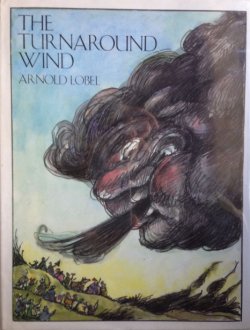Gareth B. Matthews

Review of The Turnaround Wind by Arnold Lobel (New York: Harper and Row, 1988). Originally published in Thinking: The Journal of Philosophy for Children 8(1): 1.
One afternoon in summer the landscape was filled with happy beings: an organ grinder and his monkey, a stout man and his slender wife, a nurse wheeling a baby in a carriage, a maiden and a soldier-and many more, including their royal majesties, the King and Queen. Suddenly a dark and ominous cloud appeared and “seemed to turn the whole world around and around and upside down.”
The story of this upside-down world is shown to us in a remarkable sequence of ambiguous pictures. We are given, one by one, a picture of each of the characters introduced at the beginning, but now combined in such a way that one person is portrayed when we look at the picture with the book right side up, but then when we turn the book upside down to read the inverted writing at the top of the page, the picture becomes that of another person, or even an animal. Thus, the organ grinder (straight up) becomes, when inverted, the sailor’s parrot; the stout man becomes his slender wife, etc. After we have been re-introduced to each character, we learn that the storm was quickly over, and the previous order has been restored. “Everyone dusted themselves off and walked serenely in the sunshine of a lovely afternoon.” At sunset all went home to supper, except the thief, who stayed out in the dark, looking for
things to steal.
Long-term readers of this column may recall being introduced here to Arnold Label’s philosophical classic, Frog and Toad Together. (vol. 1, no. 1, and again, vol. 6, no. 2) It is sad to realize that this new, posthumously published book is the last story we shall have from perhaps the most philosophically inventive author and illustrator of children’s books in our time. Still, we can be thankful for yet another mischievously and humorously thought-provoking book. I say “book;” rather than “story,” because Arnold Label’s cleverness in illustrating this story is essential to its success. Wittgenstein’s “duck-rabbit” in his Philosophical Investigations (p. 194)-the figure that, looked at from one angle is unambiguously a duck, and looked at from another is unambiguously a rabbit-can be thought of as the prototype for Label’s much more complexly equivocal pictures. But the prototype in a child’s own experience is much more likely to be the fascinating game of making ambiguous shadow figures on the bedroom wall at night or lying on one’s back on a summer’s day and identifying shapes in the cloud’s overhead. In my own navy days, I lived for a time with a gifted caricaturist, who could quickly reduce a menacing authority figure to innocuousness by drawing him, convincingly, as a playful monkey, or perhaps as a self-important bird. Who were those people my friend could so easily and effectively caricature, something quite independent of all the caricatures? Something approximated to by the sum of all the caricatures? Or what? Arnold Label’s wonderful pictures give us, whether we are young or old, the fascinating fun of playing again the “duck-rabbit” game. But they also encourage us to reflect on whether some turnaround wind in our lives might help us see those around us in startling ways that will reveal some thing we had previously missed. It has sometimes struck me, for example, that people naturally imitate their pets, or maybe pets naturally imitate their owners, or perhaps people tend to choose pets who portray some aspect of their personality. And it is a common experience to realize suddenly that one has unconsciously treated one of one’s friends or acquaintances as the affective or functional equivalent of another.
The story’s ending is unsettling. The thief, unlike all the good citizens of the community, stays out in the dark to look for things to steal. Will this ending upset child readers?
Children are widely thought to want their stories to have neat and moral conclusions. But it is hard to be clear about what children really want, as opposed to what we, their parents and teachers, want for them. And it is even harder to know what we should try to protect them from. Perhaps, even without turning upside down the thief’s picture on the last page of the story, we are meant to see ourselves in his face, or at least to recognize in his mischief that part of ourselves that rebels against peace and order. If, in fact, we do this, we have been encouraged by Arnold Label’s wonderfully provocative book to take another step toward self-knowledge.
